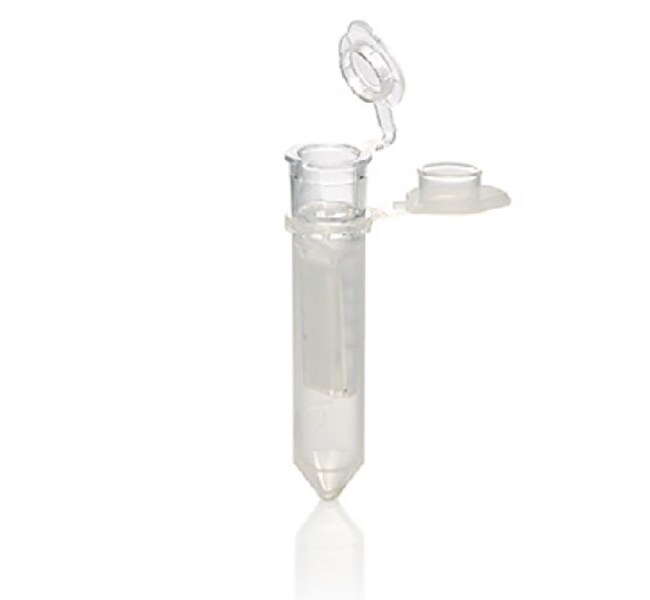Search
Thermo Scientific™
Concentrador de proteínas de PES Pierce™, MWCO de 30 K, de 5 a 20 ml
Los concentradores de proteínas de PES Thermo Scientific™ Pierce™ son dispositivos de ultrafiltración centrífuga desechables con una membrana de polietersulfonaMás información
| Número de catálogo | Cantidad | Volumen de muestra |
|---|---|---|
| 88502 | 25 concentradores | ≤ 0,5ml |
| 88521 | 10 concentradores | De 2 a 6 ml |
| 88522 | 24 concentradores | De 2 a 6 ml |
| 88529 | 10 concentradores | De 5 a 20 ml |
| 88531 | 24 concentradores | De 5 a 20 ml |
| 88536 | 4 concentradores | De 20 a 100 ml |
Número de catálogo 88502
Precio (MXN)
-
Cantidad:
25 concentradores
Volumen de muestra:
≤ 0,5ml
Los concentradores de proteínas de PES Thermo Scientific™ Pierce™ son dispositivos de ultrafiltración centrífuga desechables con una membrana de polietersulfona (PES) para la concentración, la desalinización y el intercambio de tampones de muestras biológicas.Este producto tiene un tope de peso molecular (MWCO) de 30K y se puede utilizar para el procesamiento de volúmenes de muestra de 5 a 20 ml.
Características de los concentradores de proteínas de PES Pierce:
•Concentración proteica rápida: puede conseguirse una concentración de la muestra de 10 a 30 veces en un periodo de 5 a 30 minutos para MWCO de 10K (el tiempo puede variar para un producto con un MWCO diferente)
• Excelente recuperación de proteínas: la recuperación de proteínas típica es >90 %
• Versatilidad: concentración de muestras sencillo, diafiltración o intercambio de tampones de muestras biológicas
• Compatibilidad: puede usarse tanto en rotores de ángulo fijo como en rotores de vasos basculantes; recoger y recuperar muestras sin centrifugación inversa
Para facilitar la identificación, el valor de MWCO se graba en el lateral de cada dispositivo.Para facilitar la adición y recuperación de muestras, hay una ventana transparente con graduaciones en el lateral de cada dispositivo, lo que permite la determinación visual del volumen de retención.El diseño vertical de la membrana permite altas velocidades de flujo, baja unión no específica y una agregación proteica insignificante en la membrana; y proporciona resultados fiables y coherentes.
Los concentradores de proteínas de PES Pierce contienen una membrana clasificada para retener moléculas con un peso molecular al menos 2 veces mayor que la clasificación MWCO de la membrana de PES del dispositivo.Una menor recuperación puede ocurrir cuando se usa un concentrador con moléculas más pequeñas que la masa recomendada.La recuperación de proteínas variará dependiendo de la proteína específica de la muestra y de su concentración inicial.Para lograr una recuperación >90 % de la proteína, la concentración mínima de la muestra de proteína debe ser de 0,1 mg/ml.
Características de los concentradores de proteínas de PES Pierce:
•Concentración proteica rápida: puede conseguirse una concentración de la muestra de 10 a 30 veces en un periodo de 5 a 30 minutos para MWCO de 10K (el tiempo puede variar para un producto con un MWCO diferente)
• Excelente recuperación de proteínas: la recuperación de proteínas típica es >90 %
• Versatilidad: concentración de muestras sencillo, diafiltración o intercambio de tampones de muestras biológicas
• Compatibilidad: puede usarse tanto en rotores de ángulo fijo como en rotores de vasos basculantes; recoger y recuperar muestras sin centrifugación inversa
Para facilitar la identificación, el valor de MWCO se graba en el lateral de cada dispositivo.Para facilitar la adición y recuperación de muestras, hay una ventana transparente con graduaciones en el lateral de cada dispositivo, lo que permite la determinación visual del volumen de retención.El diseño vertical de la membrana permite altas velocidades de flujo, baja unión no específica y una agregación proteica insignificante en la membrana; y proporciona resultados fiables y coherentes.
Los concentradores de proteínas de PES Pierce contienen una membrana clasificada para retener moléculas con un peso molecular al menos 2 veces mayor que la clasificación MWCO de la membrana de PES del dispositivo.Una menor recuperación puede ocurrir cuando se usa un concentrador con moléculas más pequeñas que la masa recomendada.La recuperación de proteínas variará dependiendo de la proteína específica de la muestra y de su concentración inicial.Para lograr una recuperación >90 % de la proteína, la concentración mínima de la muestra de proteína debe ser de 0,1 mg/ml.
For Research Use Only. Not for use in diagnostic procedures.
Especificaciones
Línea de productosPierce
Diana de purificaciónproteína
Cantidad25 concentradores
Condiciones de envíoTemperatura ambiente
TipoFiltro
DesechablesSí
Tipo de filtroFiltro de membrana
FormatoMicrocentrífuga, columna de centrifugación
MWCO30 kDa
Material (membrana)PES
Volumen de muestra≤ 0,5ml
Unit SizeEach
Contenido y almacenamiento
Almacenar a temperatura ambiente.


